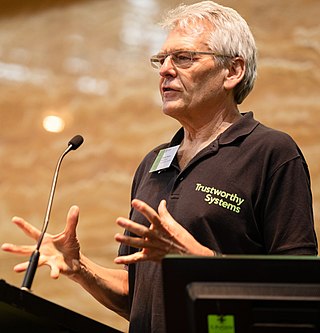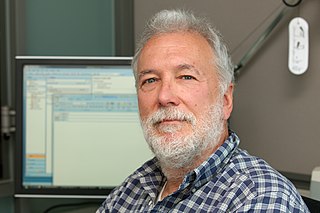
Non-uniform memory access (NUMA) is a computer memory design used in multiprocessing, where the memory access time depends on the memory location relative to the processor. Under NUMA, a processor can access its own local memory faster than non-local memory. The benefits of NUMA are limited to particular workloads, notably on servers where the data is often associated strongly with certain tasks or users.

John Leroy Hennessy is an American computer scientist who is chairperson of Alphabet Inc. (Google). Hennessy is one of the founders of MIPS Technologies and Atheros, and also the tenth President of Stanford University. Hennessy announced that he would step down in the summer of 2016. He was succeeded as president by Marc Tessier-Lavigne. Marc Andreessen called him "the godfather of Silicon Valley."
Cache only memory architecture (COMA) is a computer memory organization for use in multiprocessors in which the local memories at each node are used as cache. This is in contrast to using the local memories as actual main memory, as in NUMA organizations.
In computer science, load-linked/store-conditional (LL/SC), sometimes known as load-reserved/store-conditional (LR/SC), are a pair of instructions used in multithreading to achieve synchronization. Load-link returns the current value of a memory location, while a subsequent store-conditional to the same memory location will store a new value only if no updates have occurred to that location since the load-link. Together, this implements a lock-free, atomic, read-modify-write operation.
Thread Level Speculation (TLS), also known as Speculative Multi-threading, or Speculative Parallelization, is a technique to speculatively execute a section of computer code that is anticipated to be executed later in parallel with the normal execution on a separate independent thread. Such a speculative thread may need to make assumptions about the values of input variables. If these prove to be invalid, then the portions of the speculative thread that rely on these input variables will need to be discarded and squashed. If the assumptions are correct the program can complete in a shorter time provided the thread was able to be scheduled efficiently.
Maurice Peter Herlihy is an American computer scientist active in the field of multiprocessor synchronization. Herlihy has contributed to areas including theoretical foundations of wait-free synchronization, linearizable data structures, applications of combinatorial topology to distributed computing, as well as hardware and software transactional memory. He is the An Wang Professor of Computer Science at Brown University, where he has been a member of the faculty since 1994.
The International Symposium on Computer Architecture (ISCA) is an annual academic conference on computer architecture, generally viewed as the top-tier in the field. Association for Computing Machinery's Special Interest Group on Computer Architecture and Institute of Electrical and Electronics Engineers Computer Society are technical sponsors.

Gernot Heiser is a Scientia Professor and the John Lions Chair for operating systems at UNSW Sydney, where he leads the Trustworthy Systems group (TS).

James Richard "Jim" Goodman retired as professor of computer science at the University of Auckland in Auckland, New Zealand, and emeritus professor at the University of Wisconsin–Madison.

The SGI Origin 2000 is a family of mid-range and high-end server computers developed and manufactured by Silicon Graphics (SGI). They were introduced in 1996 to succeed the SGI Challenge and POWER Challenge. At the time of introduction, these ran the IRIX operating system, originally version 6.4 and later, 6.5. A variant of the Origin 2000 with graphics capability is known as the Onyx2. An entry-level variant based on the same architecture but with a different hardware implementation is known as the Origin 200. The Origin 2000 was succeeded by the Origin 3000 in July 2000, and was discontinued on June 30, 2002.

Oyekunle Ayinde "Kunle" Olukotun is a British-born Nigerian computer scientist who is the Cadence Design Systems Professor of the Stanford School of Engineering, Professor of Electrical Engineering and Computer Science at Stanford University and the director of the Stanford Pervasive Parallelism Lab. Olukotun is known as the “father of the multi-core processor”, and the leader of the Stanford Hydra Chip Multiprocessor research project. Olukotun's achievements include designing the first general-purpose multi-core CPU, innovating single-chip multiprocessor and multi-threaded processor design, and pioneering multicore CPUs and GPUs, transactional memory technology and domain-specific languages programming models. Olukotun's research interests include computer architecture, parallel programming environments and scalable parallel systems, domain specific languages and high-level compilers.

Tachyon is a parallel/multiprocessor ray tracing software. It is a parallel ray tracing library for use on distributed memory parallel computers, shared memory computers, and clusters of workstations. Tachyon implements rendering features such as ambient occlusion lighting, depth-of-field focal blur, shadows, reflections, and others. It was originally developed for the Intel iPSC/860 by John Stone for his M.S. thesis at University of Missouri-Rolla. Tachyon subsequently became a more functional and complete ray tracing engine, and it is now incorporated into a number of other open source software packages such as VMD, and SageMath. Tachyon is released under a permissive license.

Anna R. Karlin is an American computer scientist, the Microsoft Professor of Computer Science & Engineering at the University of Washington.
Margaret Martonosi is an American computer scientist who is currently the Hugh Trumbull Adams '35 Professor of Computer Science at Princeton University. Martonosi is noted for her research in computer architecture and mobile computing with a particular focus on power-efficiency.
In the electronics industry, dark silicon is the amount of circuitry of an integrated circuit that cannot be powered-on at the nominal operating voltage for a given thermal design power (TDP) constraint.
In computing, energy proportionality is a measure of the relationship between power consumed in a computer system, and the rate at which useful work is done. If the overall power consumption is proportional to the computer's utilization, then the machine is said to be energy proportional. Equivalently stated, for an idealized energy proportional computer, the overall energy per operation is constant for all possible workloads and operating conditions.
Cache prefetching is a technique used by computer processors to boost execution performance by fetching instructions or data from their original storage in slower memory to a faster local memory before it is actually needed. Most modern computer processors have fast and local cache memory in which prefetched data is held until it is required. The source for the prefetch operation is usually main memory. Because of their design, accessing cache memories is typically much faster than accessing main memory, so prefetching data and then accessing it from caches is usually many orders of magnitude faster than accessing it directly from main memory. Prefetching can be done with non-blocking cache control instructions.

Nader Bagherzadeh is a professor of computer engineering in the Department of Electrical Engineering and Computer Science at the University of California, Irvine, where he served as a chair from 1998 to 2003. Bagherzadeh has been involved in research and development in the areas of: Computer Architecture, Reconfigurable Computing, VLSI Chip Design, Network-on-Chip, 3D chips, Sensor Networks, Computer Graphics, Memory and Embedded Systems. Bagherzadeh was named Fellow of the Institute of Electrical and Electronics Engineers (IEEE) in 2014 for contributions to the design and analysis of coarse-grained reconfigurable processor architectures. Bagherzadeh has published more than 400 articles in peer-reviewed journals and conferences. He was with AT&T Bell Labs from 1980 to 1984.
Timothy M. Pinkston is an American computer engineer, researcher, educator and administrator whose work is focused in the area of computer architecture. He holds the George Pfleger Chair in Electrical and Computer Engineering and is a Professor of Electrical and Computer Engineering at University of Southern California (USC). He also serves in an administrative role as Vice Dean for Faculty Affairs at the USC Viterbi School of Engineering.
Trevor Mudge is a computer scientist, academic and researcher. He is the Bredt Family Chair of Computer Science and Engineering, and Professor of Electrical Engineering and Computer Science at the University of Michigan.








